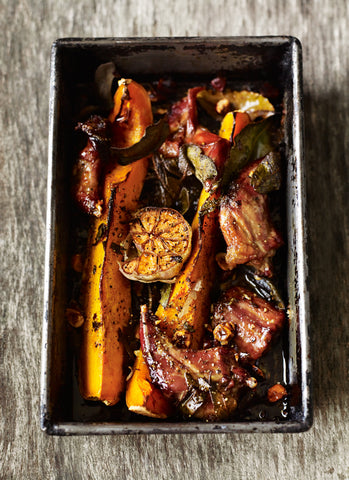Squirrel: why everyone should try it
by Robert Gooch May 24 2017
Many Americans consider squirrel the best meat in the woods – yet very few Brits have even tried it. Sweet and nutty, squirrel is a highly sustainable and delicious meat that we would like to see on many more plates.
 With consumers becoming more conscious about sustainability, and chefs seeking out more exciting ingredients, squirrel has been attracting a lot of attention lately. Gordon Ramsey and Jamie Oliver are fans, and squirrel dishes can now regularly be seen on a growing number of restaurant menus, including Hugh Fearnley-Whittingstall’s River Cottage Canteen.
With consumers becoming more conscious about sustainability, and chefs seeking out more exciting ingredients, squirrel has been attracting a lot of attention lately. Gordon Ramsey and Jamie Oliver are fans, and squirrel dishes can now regularly be seen on a growing number of restaurant menus, including Hugh Fearnley-Whittingstall’s River Cottage Canteen.
In the US, hunting and cooking squirrel is a tradition continued by around 1.8 million Americans, according to a recent national survey. Squirrel is one of the country’s most popular game meats, especially in the South where Brunswick stew – made with squirrel, tomatoes, lima beans and okra –has been a favourite since the 19th century.
After the Second World War, squirrel’s popularity dwindled over here in the UK, and farmed meats such as chicken became the mainstay of our diets. Today, the UK’s squirrel population is around 5 million, yet the majority of Brits haven’t even considered eating this abundant, delicious and nutritious meat.
Not everyone has forgotten how tasty squirrel and other game meats can be, though – and here at the Wild Meat Company, we are proud to be among those championing this healthy, ethical and environmentally-friendly food.
What does squirrel taste like?
Squirrel tastes like a subtler version of rabbit, with some saying the flavour resembles a cross between rabbit and chicken – with a hint of nuts. The meat is sweet, light in colour and finely textured.
Our squirrels are supplied skinned and whole, unless requested in fur, and we recommend allowing one per person. Ideal for casseroling or slow cooking, the haunches (back legs) provide the most meat.
Squirrel cooking methods
Casseroling or slow-cooking at a low temperature is our favourite way of cooking squirrel. Brown the meat before transferring it to a casserole dish with vegetables, stock, wine and/or tomatoes. Cook in a gentle oven (between 100ºC and 150ºC) for 4–8 hours, according to your recipe.
Squirrel is also delicious roasted but, as with most game meats, make sure you baste it well with oil or fat to prevent the lean meat from drying out. Allow 45–60 minutes in an oven at 190°C (375°F/gas mark 5).
To pan fry the meat with the haunches, we recommend parboiling the carcass to help remove the meat from the bones. We then love it Southern fried in crispy breadcrumbs.
Spatchcocked squirrel, meanwhile, is great for the barbecue. Marinating overnight helps tenderise the meat, and squirrel is a perfect match for a syrupy barbecue sauce.
Former National Chef of the Year Kevin Viner has also created a recipe for Cornish squirrel pasty, which proved a hit in his home county. You can find the recipe below if you want to try it at home.
Ideal flavours for squirrel
Squirrel is an adaptable ingredient that can be enjoyed with a wide range of flavours. Unsurprisingly, it goes particularly well with nuts and berries but it also holds its own in big bold tomato sauces or creamy dishes.
Recipes with bacon and sausages are also delicious and the pork fat helps prevent the meat drying out.
Herbs: rosemary, sage, thyme, parsley
Spices: cayenne, paprika, chilli
Alcohol: dry red wine (e.g. Claret), cider, ale
Our favourite squirrel recipes
- Kevin Viner's squirrel pasties
- Gill Meller’s roast squirrel with squash, sage & hazelnuts
- Game-to-eat’s slow-cooked squirrel and chorizo stew
- Robert Owen Brown’s Southern fried crispy squirrel
- Braised squirrel
- Hobo stew
- Squirrel stew with paprika and greens

